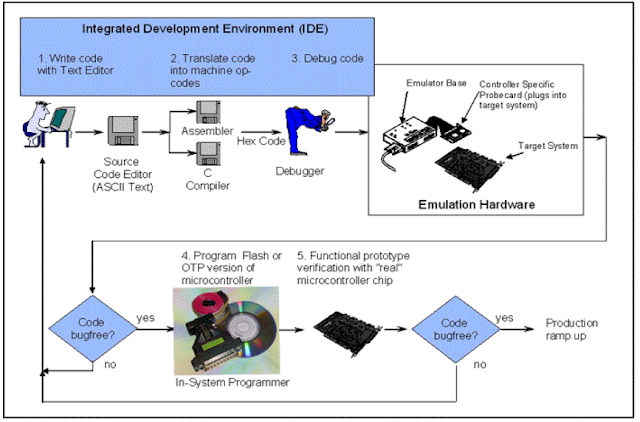Embedded system development
environment – IDE:-
- An Integrated Development Environment (IDE) is software that assists programmers in developing software
- IDEs normally consist of a source code editor, a compiler, a linker/locater and usually a debugger. Sometimes, an IDE is devoted to one specific programming language or one (family of) specific processor or hardware
- But more often the IDEs support multiple languages, processors, etc. Some commonly used IDEs for embedded systems are the GNU compiler collection (gcc), Eclipse, Delphi,
Editor:-
- A source code editor is a text editor program designed specifically for editing source code to control embedded systems.
- It may be a standalone application or it may be built into an integrated development environment (e.g. IDE).
- Source code editors may have features specifically designed to simplify and speed up input of source code, such as syntax highlighting and auto complete functionality.
- These features ease the development of code
Compiler:-
- A compiler is a computer program that translates the source code into computer language (object code).
- Commonly the output has a form suitable for processing by other programs (e.g., a linker), but it may be a human readable text file.
- A compiler translates source code from a high level language to a lower level language (e.g., assembly language or machine language).
- The most common reason for wanting to translate source code is to create a program that can be executed on a computer or on an embedded system.
- The compiler is called a cross compiler if the source code is compiled to run on a platform other than the one on which the cross compiler is run.
- For embedded systems the compiler always runs on another platform, so a cross compiler is needed.
Linker:-
- A linker or link editor is a program that takes one or more objects generated by compilers and assembles them into a single executable program or a library that can later be linked to in itself.
- All of the object files resulting from compiling must be combined in a special way before the program locator will produce an output file that contains a binary image that can be loaded into the target ROM.
- A commonly used linker/locater for embedded systems isld (GNU).
Debugger:-
- A debugger is a computer program that is used to test and debug other programs
- A debugger is a piece of software running on the PC, which has to be tightly integrated with the emulator that you use to validate your code.
- A Debugger allows you to download your code to the emulator's memory and then control all of the functions of the emulator from a PC
Debugging Tools:-
When it comes to debugging your code and
testing your application there are several
different tools you can utilize that differ
greatly in terms of development time spend
and debugging features available. In this
section we take a look
at simulators, and emulators.




